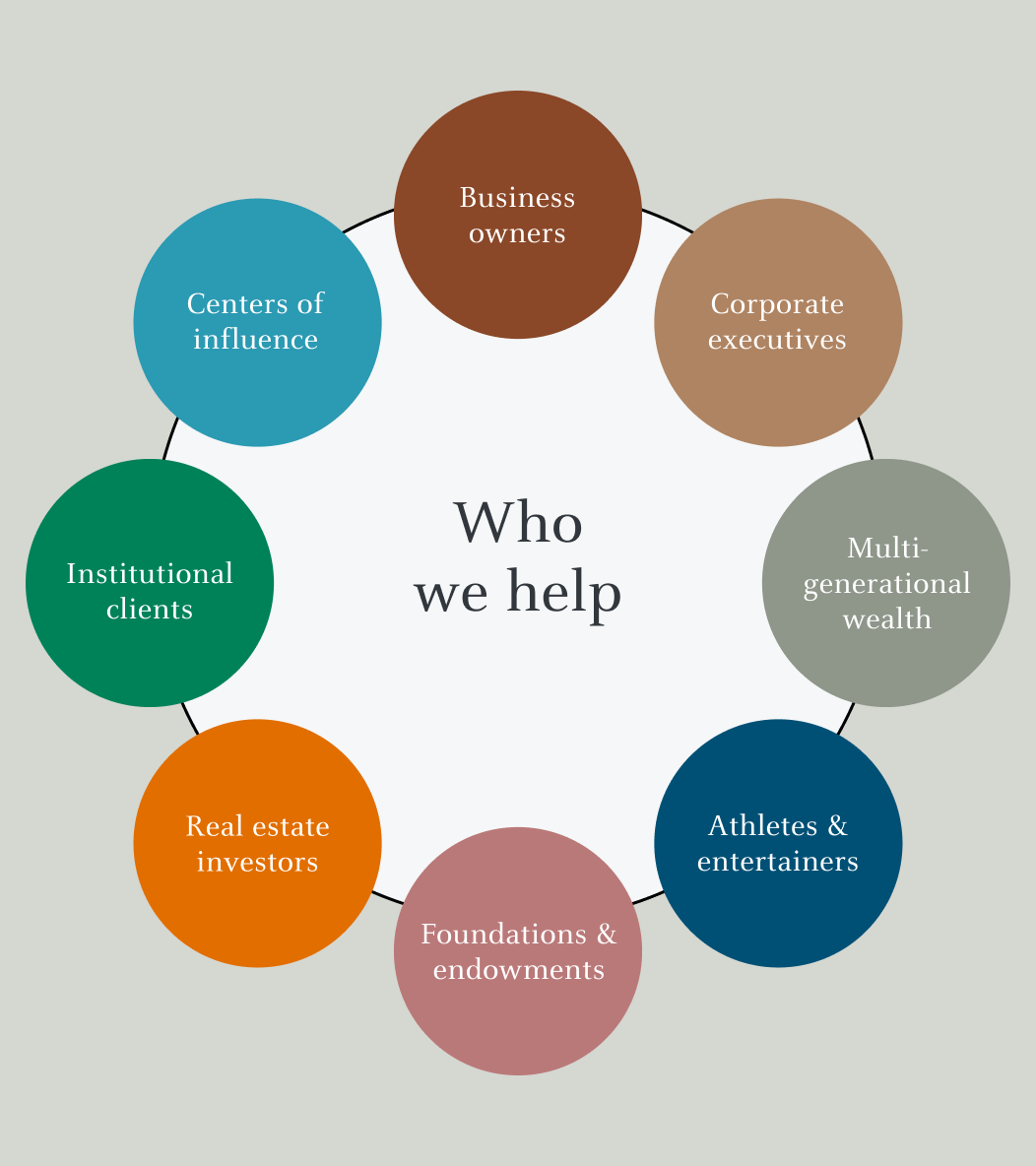Your Wealth Advisor goes beyond just selecting investments by crafting a custom wealth plan that supports your lifestyle, values and personal priorities—from helping ensure the success of your family and your business to being a part of the creation of a legacy that can benefit future generations.
J.P. Morgan Wealth Advisors
Your partner in navigating significant wealth
Your Wealth Advisor is at your side, offering trusted guidance that is centered around you and what you aspire to achieve.


Your single point of contact for all your financial needs
Your Wealth Advisor is dedicated to helping you simplify the complex—providing highly-personalized support and strategies to help guide you through every milestone and opportunity.

Advice for more than just your finances
With decades of experience serving some of the wealthiest individuals and institutions, our advisors and teams are uniquely prepared to address even the most complex challenges, backed by the resources of one of the world’s most respected financial firms.
You and your Wealth Advisor have access to customized products and specialized services built for high- and ultra-high-net-worth clients, as well as alternative investments, award-winning research and environmental, social and governance strategies.
Dedicated to serving you

Dedicated to serving you
Explore our services
See how your Wealth Advisor can connect you to J.P. Morgan’s vast network of investing strategists, wealth planning professionals, family wealth experts and lending and banking specialists.
Meet our advisors
Use our Wealth Advisor search tool to find an advisor that resonates with you, then reach out to them directly by phone or email to tell them about your specific needs and priorities.
See our approach
Learn about our highly-personalized approach to wealth management, and explore our secure digital tools, cybersecurity resources and community initiatives.

Family Wealth Institute
Unravel the complexities of family wealth with educational resources on trusts and estates, business planning, retirement, family engagement and governance, lifestyle, philanthropy and more.
Recognized by the industry
Our elite advisors and teams are consistently recognized by industry-leading publications
Barron's
Top 100 Private Wealth Management Teams
2023,2022,2021,2020,2019
Top 100 Financial Advisors
2025, 2024, 2023, 2022, 2021, 2020, 2019, 2018, 2017, 2016
Top 100 Women Financial Advisors
2025, 2024, 2023, 2022, 2021, 2020, 2019, 2018, 2017, 2016
Top 1,200 Advisors
2025, 2024, 2023, 2022, 2021, 2020, 2019, 2018, 2017, 2016
Forbes/SHOOK
Top Wealth Advisors
2025, 2024, 2023, 2022, 2021, 2020, 2019, 2018, 2017, 2016
Top Women Wealth Advisors
2025, 2024, 2023, 2022, 2021, 2020, 2019, 2018, 2017
Top Next-Gen Wealth Advisors
2025, 2024, 2023, 2022, 2021, 2020, 2019, 2018, 2017
Top Wealth Advisors Best-In-State
2025, 2024, 2023, 2022, 2021, 2020, 2019, 2018, 2017
Awards or rankings are not indicative of future success or results.
Forbes/SHOOK Top Wealth Advisors
2025
Forbes/SHOOK Top Wealth Advisors (4/8/25). Data as of 6/30/24. The Forbes ranking of America’s Top Wealth Advisors is based on an algorithm of qualitative criteria, mostly gained through telephone and in-person due diligence interviews, and quantitative data. Those advisors that are considered have a minimum of seven years’ experience, and the algorithm weighs factors like revenue trends, assets under management, compliance records, industry experience and those that encompass best practices and approach to working with clients. Portfolio performance is not a criterion due to varying client objectives and lack of audited data. Ratings may not guarantee future success or results. Fee paid to rating provider for advertisement materials after rating announced.
2024
Forbes/SHOOK Top Wealth Advisors (4/3/24). Data as of 6/30/23. The Forbes ranking of America’s Top Wealth Advisors is based on an algorithm of qualitative criteria, mostly gained through telephone and in-person due diligence interviews, and quantitative data. Those advisors that are considered have a minimum of seven years’ experience, and the algorithm weighs factors like revenue trends, assets under management, compliance records, industry experience and those that encompass best practices and approach to working with clients. Portfolio performance is not a criterion due to varying client objectives and lack of audited data. Ratings may not guarantee future success or results. Fee paid to rating provider for advertisement materials after rating announced.
2023
Forbes/SHOOK Top Wealth Advisors (4/4/23). Data as of 6/30/22. The Forbes ranking of America’s Top Wealth Advisors is based on an algorithm of qualitative criteria, mostly gained through telephone and in-person due diligence interviews, and quantitative data. Those advisors that are considered have a minimum of seven years’ experience, and the algorithm weighs factors like revenue trends, assets under management, compliance records, industry experience and those that encompass best practices and approach to working with clients. Portfolio performance is not a criterion due to varying client objectives and lack of audited data. Ratings may not guarantee future success or results. Fee paid to rating provider for advertisement materials after rating announced.
2022
Forbes/SHOOK Top Wealth Advisors (8/24/22). Data as of 3/31/22. The Forbes ranking of America’s Top Wealth Advisors is based on an algorithm of qualitative criteria, mostly gained through telephone and in-person due diligence interviews, and quantitative data. Those advisors that are considered have a minimum of seven years’ experience, and the algorithm weighs factors like revenue trends, assets under management, compliance records, industry experience and those that encompass best practices and approach to working with clients. Portfolio performance is not a criterion due to varying client objectives and lack of audited data. Ratings may not guarantee future success or results. Fee paid to rating provider for advertisement materials after rating announced.
2021
Forbes/SHOOK Top Wealth Advisors (8/24/21). Data as of 3/31/21. The Forbes ranking of America’s Top Wealth Advisors is based on an algorithm of qualitative criteria, mostly gained through telephone and in-person due diligence interviews, and quantitative data. Those advisors that are considered have a minimum of seven years’ experience, and the algorithm weighs factors like revenue trends, assets under management, compliance records, industry experience and those that encompass best practices and approach to working with clients. Portfolio performance is not a criterion due to varying client objectives and lack of audited data. Ratings may not guarantee future success or results. Fee paid to rating provider for advertisement materials after rating announced.
2020
Forbes/SHOOK Top Wealth Advisors (8/25/20). Data as of 3/31/20. The Forbes ranking of America’s Top Wealth Advisors is based on an algorithm of qualitative criteria, mostly gained through telephone and in-person due diligence interviews, and quantitative data. Those advisors that are considered have a minimum of seven years’ experience, and the algorithm weighs factors like revenue trends, assets under management, compliance records, industry experience and those that encompass best practices in their practices and approach to working with clients. Portfolio performance is not a criterion due to varying client objectives and lack of audited data. Ratings may not guarantee future success or results. Fee paid to rating provider for advertisement materials after rating announced.
2019
Forbes/SHOOK Top Wealth Advisors (9/10/19). Data as of 3/31/19. The Forbes ranking of America’s Top Wealth Advisors is based on an algorithm of qualitative criteria, mostly gained through telephone and in-person due diligence interviews, and quantitative data. Those advisors that are considered have a minimum of seven years’ experience, and the algorithm weighs factors like revenue trends, assets under management, compliance records, industry experience and those that encompass best practices in their practices and approach to working with clients. Portfolio performance is not a criterion due to varying client objectives and lack of audited data. Ratings may not guarantee future success or results. Fee paid to rating provider for advertisement materials after rating announced.
2018
Forbes/SHOOK Top Wealth Advisors (9/12/18). Data as of 6/30/18. The Forbes ranking of America’s Top Wealth Advisors is based on an algorithm of qualitative criteria, mostly gained through telephone and in-person due diligence interviews, and quantitative data. Those advisors that are considered have a minimum of seven years experience, and the algorithm weighs factors like revenue trends, assets under management, compliance records, industry experience and those that encompass best practices in their practices and approach to working with clients. Portfolio performance is not a criterion due to varying client objectives and lack of audited data. Ratings may not guarantee future success or results. Fee paid to rating provider for advertisement materials after rating announced.
2017
Forbes/SHOOK Top Wealth Advisors (9/26/17). Data as of 6/30/17. The Forbes ranking of America’s Top Wealth Advisors is based on an algorithm of qualitative criteria, mostly gained through telephone and in-person due diligence interviews, and quantitative data. Those advisors that are considered have a minimum of seven years experience, and the algorithm weighs factors like revenue trends, assets under management, compliance records, industry experience and those that encompass best practices in their practices and approach to working with clients. Portfolio performance is not a criterion due to varying client objectives and lack of audited data. Ratings may not guarantee future success or results. Fee paid to rating provider for advertisement materials after rating announced.
2016
Forbes/SHOOK Top Wealth Advisors (8/3/16). Data as of 6/30/16. The Forbes ranking of America’s Top Wealth Advisors is based on an algorithm of qualitative criteria, mostly gained through telephone and in-person due diligence interviews, and quantitative data. Those advisors that are considered have a minimum of seven years experience, and the algorithm weighs factors like revenue trends, assets under management, compliance records, industry experience and those that encompass best practices in their practices and approach to working with clients. Portfolio performance is not a criterion due to varying client objectives and lack of audited data. Ratings may not guarantee future success or results. Fee paid to rating provider for advertisement materials after rating announced.
Forbes/SHOOK Top Women Wealth Advisors
2025
Forbes/SHOOK Top Women Wealth Advisors (2/11/25). Data as of 9/30/24. The Forbes ranking of America’s Top Women Wealth Advisors ranking is based on in-person, virtual and telephone due diligence meetings to evaluate each advisor qualitatively, a major component of a ranking algorithm that includes: client impact, industry experience, review of best practices and compliance records, firm nominations; and quantitative criteria, including: assets under management and revenue generated for their firms. Investment performance is not a criterion because client objectives and risk tolerances vary, and advisors rarely have audited performance reports. Ratings may not guarantee future success or results. Fee paid to rating provider for advertisement materials after rating announced.
2024
Forbes/SHOOK Top Women Wealth Advisors (2/8/24). Data as of 9/30/23. The Forbes ranking of America’s Top Women Wealth Advisors ranking is based on in-person, virtual and telephone due diligence meetings to evaluate each advisor qualitatively, a major component of a ranking algorithm that includes: client impact, industry experience, review of best practices and compliance records, firm nominations; and quantitative criteria, including: assets under management and revenue generated for their firms. Investment performance is not a criterion because client objectives and risk tolerances vary, and advisors rarely have audited performance reports. Ratings may not guarantee future success or results. Fee paid to rating provider for advertisement materials after rating announced.
2023
Forbes/SHOOK Top Women Wealth Advisors (2/1/23). Data as of 9/30/22. The Forbes ranking of America’s Top Women Wealth Advisors ranking is based on in-person, virtual and telephone due diligence meetings to evaluate each advisor qualitatively, a major component of a ranking algorithm that includes: client impact, industry experience, review of best practices and compliance records, firm nominations; and quantitative criteria, including: assets under management and revenue generated for their firms. Investment performance is not a criterion because client objectives and risk tolerances vary, and advisors rarely have audited performance reports. Ratings may not guarantee future success or results. Fee paid to rating provider for advertisement materials after rating announced.
2022
Forbes/SHOOK Top Women Wealth Advisors (2/4/22). Data as of 9/30/21. The Forbes ranking of America’s Top Women Wealth Advisors and Top Women Wealth Advisors Best-In-State is based on an algorithm of qualitative data, learned through surveys and interviews conducting in-person, by telephone and virtually to evaluate best practices, level of service, investing models and compliance records as well as quantitative data, such as revenue trends and assets under management. All advisors have a minimum of seven years’ experience. Portfolio performance is not a criteria due to varying client objectives and lack of audited data. Ratings may not guarantee future success or results. Fee paid to rating provider for advertisement materials after rating announced.
2021
Forbes/SHOOK Top Women Wealth Advisors (3/24/21). Data as of 9/30/20. The Forbes ranking of America’s Top Women Wealth Advisors is based on an algorithm of qualitative data, learned through surveys and interviews (in-person, telephone and virtual), so we can evaluate best practices, service and investing models, compliance records, etc.; as well as quantitative data, like revenue trends and assets under management. All advisors have a minimum of seven years’ experience. Portfolio performance is not a criteria due to varying client objectives and lack of audited data. Ratings may not guarantee future success or results. Fee paid to rating provider for advertisement materials after rating announced.
2020
Forbes/SHOOK Top Women Wealth Advisors (4/21/20). Data as of 9/30/19. The Forbes ranking of America’s Top Women Wealth Advisors is based on an algorithm of qualitative data, such as telephone and in-person interviews, a review of best practices, service and investing models, and compliance records; as well as quantitative data, like revenue trends and assets under management. All advisors have a minimum of seven years’ experience. Portfolio performance is not a criteria due to varying client objectives and lack of audited data.
2019
Forbes/SHOOK Top Women Wealth Advisors (4/30/19). Data as of 9/30/18. The Forbes ranking of America’s Top Women Wealth Advisors is based on an algorithm of qualitative and quantitative data, rating thousands of wealth advisors with a minimum of seven years of experience and weighing factors like revenue trends, assets under management, compliance records, industry experience and best practices learned through telephone and in-person interviews. Portfolio performance is not a criteria due to varying client objectives and lack of audited data. Ratings may not guarantee future success or results. Fee paid to rating provider for advertisement materials after rating announced.
2018
Forbes/SHOOK Top Women Wealth Advisors (5/1/18). Data as of 9/30/17. The Forbes ranking of America’s Top Women Wealth Advisors is based on an algorithm of qualitative and quantitative data, rating thousands of wealth advisors with a minimum of seven years of experience and weighing factors like revenue trends, assets under management, compliance records, industry experience and best practices learned through telephone and in-person interviews. Portfolio performance is not a criteria due to varying client objectives and lack of audited data. Ratings may not guarantee future success or results. Fee paid to rating provider for advertisement materials after rating announced.
2017
Forbes/SHOOK Top Women Wealth Advisors (2/28/17). Data as of 9/30/16. The Forbes ranking of America’s Top Women Wealth Advisors is based on an algorithm of qualitative and quantitative data, rating thousands of wealth advisors with a minimum of seven years of experience and weighing factors like revenue trends, assets under management, compliance records, industry experience and best practices learned through telephone and in-person interviews. Portfolio performance is not a criteria due to varying client objectives and lack of audited data. Ratings may not guarantee future success or results. Fee paid to rating provider for advertisement materials after rating announced.
Forbes/SHOOK Top Next-Gen Wealth Advisors
2025
Forbes/SHOOK Top Next-Gen Wealth Advisors (8/6/25). Data as of 3/31/25. The Forbes Next-Gen Wealth Advisors rankings is based on an algorithm of qualitative criterion—mostly gained through telephone and in-person due diligence interviews—and quantitative data. Those advisors that are considered have a minimum of four years' experience, and the algorithm weighs factors like revenue trends, assets under management, compliance records, industry experience and those that encompass the highest standards of best practices. Portfolio performance is not a criterion due to varying client objectives and lack of audited data. Ratings may not guarantee future success or results. Fee paid to rating provider for advertisement materials after rating announced.
2024
Forbes/SHOOK Top Next-Gen Wealth Advisors (8/8/24). Data as of 3/31/24. The Forbes Next-Gen Wealth Advisors rankings is based on an algorithm of qualitative criterion—mostly gained through telephone and in-person due diligence interviews—and quantitative data. Those advisors that are considered have a minimum of four years' experience, and the algorithm weighs factors like revenue trends, assets under management, compliance records, industry experience and those that encompass the highest standards of best practices. Portfolio performance is not a criterion due to varying client objectives and lack of audited data. Ratings may not guarantee future success or results. Fee paid to rating provider for advertisement materials after rating announced.
2023
Forbes/SHOOK Top Next-Gen Wealth Advisors (8/8/23). Data as of 3/31/23. The Forbes Next-Gen Wealth Advisors rankings is based on an algorithm of qualitative criterion—mostly gained through telephone and in-person due diligence interviews—and quantitative data. Those advisors that are considered have a minimum of four years' experience, and the algorithm weighs factors like revenue trends, assets under management, compliance records, industry experience and those that encompass the highest standards of best practices. Portfolio performance is not a criterion due to varying client objectives and lack of audited data. Ratings may not guarantee future success or results. Fee paid to rating provider for advertisement materials after rating announced.
2022
Forbes/SHOOK Top Next-Gen Wealth Advisors (8/3/22). Data as of 3/31/22. The Forbes Next-Gen Wealth Advisors rankings is based on an algorithm of qualitative criterion—mostly gained through telephone and in-person due diligence interviews—and quantitative data. Those advisors that are considered have a minimum of four years' experience, and the algorithm weighs factors like revenue trends, assets under management, compliance records, industry experience and those that encompass the highest standards of best practices. Portfolio performance is not a criterion due to varying client objectives and lack of audited data. Ratings may not guarantee future success or results. Fee paid to rating provider for advertisement materials after rating announced.
2021
Forbes/SHOOK Top Next-Gen Wealth Advisors (9/21/22). Data as of 3/31/21. The Forbes Next-Gen Wealth Advisors rankings is based on an algorithm of qualitative criterion, mostly gained through telephone and in-person due diligence interviews, and quantitative data. Those advisors that are considered have a minimum of four years' experience, and the algorithm weighs factors like revenue trends, assets under management, compliance records, industry experience and those that encompass the highest standards of best practices. Portfolio performance is not a criterion due to varying client objectives and lack of audited data. Ratings may not guarantee future success or results. Fee paid to rating provider for advertisement materials after rating announced.
2020
Forbes/SHOOK Top Next-Gen Wealth Advisors (7/22/20). Data as of 3/31/20. The Forbes Next-Gen Wealth Advisors rankings is based on an algorithm of qualitative criterion, mostly gained through telephone and in-person due diligence interviews, and quantitative data. Those advisors that are considered have a minimum of four years' experience, and the algorithm weighs factors like revenue trends, assets under management, compliance records, industry experience and those that encompass the highest standards of best practices. Portfolio performance is not a criterion due to varying client objectives and lack of audited data. Ratings may not guarantee future success or results. Fee paid to rating provider for advertisement materials after rating announced.
2019
Forbes/SHOOK Top Next-Gen Wealth Advisors (6/25/19). Data as of 3/31/19. The Forbes Next-Gen Wealth Advisors rankings is based on an algorithm of qualitative criterion, mostly gained through telephone and in-person due diligence interviews, and quantitative data. Those advisors that are considered have a minimum of four years' experience, and the algorithm weighs factors like revenue trends, assets under management, compliance records, industry experience and those that encompass the highest standards of best practices. Portfolio performance is not a criterion due to varying client objectives and lack of audited data. Ratings may not guarantee future success or results. Fee paid to rating provider for advertisement materials after rating announced.
2018
Forbes/SHOOK Top Next-Gen Wealth Advisors (7/25/18). Data as of 3/31/18. The Forbes Next-Gen Wealth Advisors rankings is based on an algorithm of qualitative criterion, mostly gained through telephone and in-person due diligence interviews, and quantitative data. Those advisors that are considered have a minimum of four years' experience, and the algorithm weighs factors like revenue trends, assets under management, compliance records, industry experience and those that encompass the highest standards of best practices. Portfolio performance is not a criterion due to varying client objectives and lack of audited data. Ratings may not guarantee future success or results. Fee paid to rating provider for advertisement materials after rating announced.
2017
Forbes/SHOOK Top Next-Gen Wealth Advisors (7/25/17). Data as of 3/31/17. The Forbes Next-Gen Wealth Advisors rankings is based on an algorithm of qualitative criterion, mostly gained through telephone and in-person due diligence interviews, and quantitative data. Those advisors that are considered have a minimum of four years' experience, and the algorithm weighs factors like revenue trends, assets under management, compliance records, industry experience and those that encompass the highest standards of best practices. Portfolio performance is not a criterion due to varying client objectives and lack of audited data. Ratings may not guarantee future success or results. Fee paid to rating provider for advertisement materials
Forbes/SHOOK Top Wealth Advisors Best-In State
2025
Forbes/SHOOK Top Wealth Advisors Best-In-State (4/8/25). Data as of 6/30/24. The Forbes ranking of Top Wealth Advisors Best-In-State is based on an algorithm of qualitative criteria, gained through telephone, virtual and in-person due diligence interviews, and quantitative data. Those advisors that are considered have a minimum of seven years experience, and the algorithm weighs factors like revenue trends, assets under management, compliance records, industry experience and those that encompass best practices in their approach to working with clients. Portfolio performance is not a criterion due to varying client objectives and lack of audited data. Ratings may not guarantee future success or results. Fee paid to rating provider for advertisement materials after rating announced.
2024
Forbes/SHOOK Top Wealth Advisors Best-In-State (4/3/24). Data as of 6/30/23. The Forbes ranking of Top Wealth Advisors Best-In-State is based on an algorithm of qualitative criteria, gained through telephone, virtual and in-person due diligence interviews, and quantitative data. Those advisors that are considered have a minimum of seven years experience, and the algorithm weighs factors like revenue trends, assets under management, compliance records, industry experience and those that encompass best practices in their approach to working with clients. Portfolio performance is not a criterion due to varying client objectives and lack of audited data. Ratings may not guarantee future success or results. Fee paid to rating provider for advertisement materials after rating announced.
2023
Forbes/SHOOK Top Wealth Advisors Best-In-State (4/4/23). Data as of 6/30/22. The Forbes ranking of Top Wealth Advisors Best-In-State is based on an algorithm of qualitative criteria, gained through telephone, virtual and in-person due diligence interviews, and quantitative data. Those advisors that are considered have a minimum of seven years experience, and the algorithm weighs factors like revenue trends, assets under management, compliance records, industry experience and those that encompass best practices in their approach to working with clients. Portfolio performance is not a criterion due to varying client objectives and lack of audited data. Ratings may not guarantee future success or results. Fee paid to rating provider for advertisement materials after rating announced.
2022
Forbes/SHOOK Best-In-State Wealth Advisors (4/7/22). Data as of 6/30/21. The Forbes ranking of Best-In-State Wealth Advisors is based on an algorithm of qualitative criteria, gained through telephone, virtual and in-person due diligence interviews, and quantitative data. Those advisors that are considered have a minimum of seven years experience, and the algorithm weighs factors like revenue trends, assets under management, compliance records, industry experience and those that encompass best practices in their approach to working with clients. Portfolio performance is not a criterion due to varying client objectives and lack of audited data. Ratings may not guarantee future success or results. Fee paid to rating provider for advertisement materials after rating announced.
2021
Forbes/SHOOK Best-In-State Wealth Advisors (2/11/21). Data as of 6/30/20. The Forbes ranking of Best-In-State Wealth Advisors is based on an algorithm of qualitative criteria, gained through telephone, virtual and in-person due diligence interviews, and quantitative data. Those advisors that are considered have a minimum of seven years experience, and the algorithm weights factors like revenue trends, assets under management, compliance records, industry experience and those that encompass best practices in their approach to working with clients. Portfolio performance is not a criteria due to varying client objectives and lack of audited data. Ratings may not guarantee future success or results. Fee paid to rating provider for advertisement materials after rating announced.
2020
Forbes/SHOOK Best-In-State Wealth Advisors (1/6/20). Data as of 6/30/19. The Forbes ranking of Best-In-State Wealth Advisors is based on an algorithm of qualitative criteria, mostly gained through telephone and in-person due diligence interviews, and quantitative data. Those advisors that are considered have a minimum of seven years experience, and the algorithm weights factors like revenue trends, assets under management, compliance records, industry experience and those that encompass best practices in their practices and approach to working with clients. Portfolio performance is not a criteria due to varying client objectives and lack of audited data. Ratings may not guarantee future success or results. Fee paid to rating provider for advertisement materials after rating announced.
2019
Forbes/SHOOK Best-In-State Wealth Advisors (2/20/19). Data as of 6/30/18. The Forbes ranking of Best-In-State Wealth Advisors is based on an algorithm of qualitative criteria, mostly gained through telephone and in-person due diligence interviews, and quantitative data. Those advisors that are considered have a minimum of seven years experience, and the algorithm weights factors like revenue trends, assets under management, compliance records, industry experience and those that encompass best practices in their practices and approach to working with clients. Portfolio performance is not a criteria due to varying client objectives and lack of audited data. Ratings may not guarantee future success or results. Fee paid to rating provider for advertisement materials after rating announced.
2018
Forbes/SHOOK Best-In-State Wealth Advisors (2/15/18). Data as of 6/30/17. The Forbes ranking of Best-In-State Wealth Advisors is based on an algorithm of qualitative criteria, mostly gained through telephone and in-person due diligence interviews, and quantitative data. Those advisors that are considered have a minimum of seven years experience, and the algorithm weights factors like revenue trends, assets under management, compliance records, industry experience and those that encompass best practices in their practices and approach to working with clients. Portfolio performance is not a criteria due to varying client objectives and lack of audited data. Ratings may not guarantee future success or results. Fee paid to rating provider for advertisement materials after rating announced.
Barron's Top 100 Private Wealth Management Teams
2023
Forbes/SHOOK Top Wealth Advisors (4/16/23). Data as of 12/31/23. The Forbes ranking of America’s Top Wealth Advisors is based on an algorithm of qualitative criteria, mostly gained through telephone and in-person due diligence interviews, and quantitative data. Those advisors that are considered have a minimum of seven years’ experience, and the algorithm weighs factors like revenue trends, assets under management, compliance records, industry experience and those that encompass best practices and approach to working with clients. Portfolio performance is not a criterion due to varying client objectives and lack of audited data. Ratings may not guarantee future success or results. Fee paid to rating provider for advertisement materials after rating announced.
2022
Barron’s Top 100 Private Wealth Management Teams (4/15/22). Data as of 12/31/21. Barron's ranks the top 100 private wealth management teams based on assets under management, revenues generated by the advisors for their firms, and the quality of advisors' practices. Ratings may not guarantee future success or results. Fee paid to rating provider for advertisement materials after rating announced.
2021
Barron’s Top 100 Private Wealth Management Teams (4/16/21). Data as of 12/31/20. Barron's ranks the top 100 private wealth management teams based on assets under management, revenues generated by the advisors for their firms, and the quality of advisors' practices. Ratings may not guarantee future success or results. Fee paid to rating provider for advertisement materials after rating announced.
2020
Barron’s Top 100 Private Wealth Management Teams (4/20/20). Data as of 12/31/19. Barron's ranks the top 100 private wealth management teams based on assets under management, revenues generated by the advisors for their firms, and the quality of advisors' practices. Ratings may not guarantee future success or results. Fee paid to rating provider for advertisement materials after rating announced.
2019
Barron’s Top 100 Private Wealth Management Teams (4/22/19). Data as of 12/31/18. Barron's ranks the top 100 private wealth management teams based on assets under management, revenues generated by the advisors for their firms, and the quality of advisors' practices. Ratings may not guarantee future success or results. Fee paid to rating provider for advertisement materials after rating announced.
Barron’s Top 100 Financial Advisors
2025
Barron’s Top 100 Financial Advisors (5/9/25). Data as of 12/31/24. Barron's ranks the top financial advisors based on assets under management, revenues generated by the advisors for their firms, and the quality of advisors' practices. Ratings may not guarantee future success or results. Fee paid to rating provider for advertisement materials after rating announced.
2024
Barron’s Top 100 Financial Advisors (5/10/24). Data as of 12/31/23. Barron's ranks the top financial advisors based on assets under management, revenues generated by the advisors for their firms, and the quality of advisors' practices. Ratings may not guarantee future success or results. Fee paid to rating provider for advertisement materials after rating announced.
2023
Barron’s Top 100 Financial Advisors (4/14/23). Data as of 12/31/22. Barron's ranks the top financial advisors based on assets under management, revenues generated by the advisors for their firms, and the quality of advisors' practices. Ratings may not guarantee future success or results. Fee paid to rating provider for advertisement materials after rating announced.
2022
Barron’s Top 100 Financial Advisors (4/15/22). Data as of 12/31/21. Barron's ranks the top financial advisors based on assets under management, revenues generated by the advisors for their firms, and the quality of advisors' practices. Ratings may not guarantee future success or results. Fee paid to rating provider for advertisement materials after rating announced.
2021
Barron’s Top 100 Financial Advisors (4/16/21). Data as of 12/31/20. Barron's ranks the top financial advisors based on assets under management, revenues generated by the advisors for their firms, and the quality of advisors' practices. Ratings may not guarantee future success or results. Fee paid to rating provider for advertisement materials after rating announced
2020
Barron’s Top 100 Financial Advisors (4/20/20). Data as of 12/31/19. Barron's ranks the top financial advisors based on assets under management, revenues generated by the advisors for their firms, and the quality of advisors' practices. Ratings may not guarantee future success or results. Fee paid to rating provider for advertisement materials after rating announced.
2019
Barron’s Top 100 Financial Advisors (4/22/19). Data as of 12/31/18. Barron's ranks the top financial advisors based on assets under management, revenues generated by the advisors for their firms, and the quality of advisors' practices. Ratings may not guarantee future success or results. Fee paid to rating provider for advertisement materials after rating announced.
2018
Barron’s Top 100 Financial Advisors (4/21/18). Data as of 12/31/17. Barron's ranks the top financial advisors based on assets under management, revenues generated by the advisors for their firms, and the quality of advisors' practices. Ratings may not guarantee future success or results. Fee paid to rating provider for advertisement materials after rating announced.
2017
Barron’s Top 100 Financial Advisors (4/15/17). Data as of 12/31/16. Barron's ranks the top financial advisors based on assets under management, revenues generated by the advisors for their firms, and the quality of advisors' practices. Ratings may not guarantee future success or results. Fee paid to rating provider for advertisement materials after rating announced.
2016
Barron’s Top 100 Financial Advisors (4/16/16). Data as of 12/31/2015. Barron's ranks the top financial advisors based on assets under management, revenues generated by the advisors for their firms, and the quality of advisors' practices. Ratings may not guarantee future success or results. Fee paid to rating provider for advertisement materials after rating announced.
Barons Top 100 Women Financial Advisors
2025
Barron's Top Women Financial Advisors (07/18/25). Data as of 03/31/25. Barron's ranks the top women financial advisors based on assets under management, revenues generated by the advisors for their firms, and the quality of advisors' practices. Ratings may not guarantee future success or results. Fee paid to rating provider for advertisement materials after rating announced.
2024
Barron’s Top Women Financial Advisors (7/19/24). Data as of 3/31/24. Barron's ranks the top women financial advisors based on assets under management, revenues generated by the advisors for their firms, and the quality of advisors' practices. Ratings may not guarantee future success or results. Fee paid to rating provider for advertisement materials after rating announced.
2023
Barron’s Top Women Financial Advisors (6/16/23). Data as of 3/31/23. Barron's ranks the top women financial advisors based on assets under management, revenues generated by the advisors for their firms, and the quality of advisors' practices. Ratings may not guarantee future success or results. Fee paid to rating provider for advertisement materials after rating announced.
2022
Barron’s Top Women Financial Advisors (6/17/22). Data as of 3/31/22. Barron's ranks the top women financial advisors based on assets under management, revenues generated by the advisors for their firms, and the quality of advisors' practices. Ratings may not guarantee future success or results. Fee paid to rating provider for advertisement materials after rating announced.
2021
Barron’s Top Women Financial Advisors (6/18/21). Data as of 3/31/21. Barron's ranks the top women financial advisors based on assets under management, revenues generated by the advisors for their firms, and the quality of advisors' practices. Ratings may not guarantee future success or results. Fee paid to rating provider for advertisement materials after rating announced.
2020
Barron’s Top Women Financial Advisors (7/17/20). Data as of 3/31/20. Barron's ranks the top women financial advisors based on assets under management, revenues generated by the advisors for their firms, and the quality of advisors' practices. Fee paid to publication for advertisement materials after rating announced. Ratings may not guarantee future success or results. Fee paid to rating provider for advertisement materials after rating announced.
2019
Barron’s Top Women Financial Advisors (6/7/19). Data as of 3/31/19. Barron's ranks the top women financial advisors based on assets under management, revenues generated by the advisors for their firms, and the quality of advisors' practices. Ratings may not guarantee future success or results. Fee paid to rating provider for advertisement materials after rating announced.
2018
Barron’s Top Women Financial Advisors (6/8/18). Data as of 3/31/18. Barron's ranks the top women financial advisors based on assets under management, revenues generated by the advisors for their firms, and the quality of advisors' practices. Ratings may not guarantee future success or results. Fee paid to rating provider for advertisement materials after rating announced.
2017
Barron’s Top Women Financial Advisors (6/15/17). Data as of 3/31/17. Barron's ranks the top women financial advisors based on assets under management, revenues generated by the advisors for their firms, and the quality of advisors' practices. Ratings may not guarantee future success or results. Fee paid to rating provider for advertisement materials after rating announced.
2016
Barron’s Top Women Financial Advisors (6/4/16). Data as of 3/31/16. Barron's ranks the top women financial advisors based on assets under management, revenues generated by the advisors for their firms, and the quality of advisors' practices. Ratings may not guarantee future success or results. Fee paid to rating provider for advertisement materials after rating announced.
Barons Top 1,200 Advisors
2025
Barron’s Top 1,200 U.S. Financial Advisors (3/7/25). Data as of 9/30/24. Barron's ranks the top 1,200 U.S. financial advisors based on assets under management, revenues generated by the advisors for their firms, and the quality of advisors' practices. Ratings may not guarantee future success or results. Fee paid to rating provider for advertisement materials after rating announced.
2024
Barron’s Top 1,200 U.S. Financial Advisors (3/8/24). Data as of 9/30/23. Barron's ranks the top 1,200 U.S. financial advisors based on assets under management, revenues generated by the advisors for their firms, and the quality of advisors' practices. Ratings may not guarantee future success or results. Fee paid to rating provider for advertisement materials after rating announced.
2023
Barron’s Top 1,200 U.S. Financial Advisors (3/10/23). Data as of 9/30/22. Barron's ranks the top 1,200 U.S. financial advisors based on assets under management, revenues generated by the advisors for their firms, and the quality of advisors' practices. Ratings may not guarantee future success or results. Fee paid to rating provider for advertisement materials after rating announced.
2022
Barron’s Top 1,200 U.S. Financial Advisors (3/11/22). Data as of 9/30/21. Barron's ranks the top 1,200 U.S. financial advisors based on assets under management, revenues generated by the advisors for their firms, and the quality of advisors' practices. Ratings may not guarantee future success or results. Fee paid to rating provider for advertisement materials after rating announced.
2021
Barron’s Top 1,200 U.S. Financial Advisors (3/12/21). Data as of 9/30/20. Barron's ranks the top 1,200 U.S. financial advisors based on assets under management, revenues generated by the advisors for their firms, and the quality of advisors' practices. Ratings may not guarantee future success or results. Fee paid to rating provider for advertisement materials after rating announced.
2020
Barron’s Top 1,200 U.S. Financial Advisors (3/13/20). Data as of 9/30/19. Barron's ranks the top 1,200 U.S. financial advisors based on assets under management, revenues generated by the advisors for their firms, and the quality of advisors' practices. Ratings may not guarantee future success or results. Fee paid to rating provider for advertisement materials after rating announced.
2019
Barron’s Top 1,200 U.S. Financial Advisors (3/8/19). Data as of 9/30/18. Barron's ranks the top 1,200 U.S. financial advisors based on assets under management, revenues generated by the advisors for their firms, and the quality of advisors' practices. Ratings may not guarantee future success or results. Fee paid to rating provider for advertisement materials after rating announced.
2018
Barron’s Top 1,200 U.S. Financial Advisors (3/8/18). Data as of 9/30/17. Barron's ranks the top 1,200 U.S. financial advisors based on assets under management, revenues generated by the advisors for their firms, and the quality of advisors' practices. Ratings may not guarantee future success or results. Fee paid to rating provider for advertisement materials after rating announced.
2017
Barron’s Top 1,200 U.S. Financial Advisors (3/15/17). Data as of 9/30/16. Barron's ranks the top 1,200 U.S. financial advisors based on assets under management, revenues generated by the advisors for their firms, and the quality of advisors' practices. Ratings may not guarantee future success or results. Fee paid to rating provider for advertisement materials after rating announced.
2016
Barron’s Top 1,200 U.S. Financial Advisors (3/5/16). Data as of 9/30/2015. Barron's ranks the top 1,200 U.S. financial advisors based on assets under management, revenues generated by the advisors for their firms, and the quality of advisors' practices. Ratings may not guarantee future success or results. Fee paid to rating provider for advertisement materials after rating announced.

Start a conversation
Our partnership begins by getting to know you personally. To get started, you can search our network to find a Wealth Advisor to work with locally or virtually, or click here to tell us about your needs and we’ll reach out to you.
LEARN MORE ABOUT OUR FIRM AND INVESTMENT PROFESSIONALS AT FINRA BROKERCHECK.
To learn more about J.P. Morgan’s investment business, including our accounts, products and services, as well as our relationship with you, please review our J.P. Morgan Securities LLC Form CRS (PDF) and Guide to Investment Services and Brokerage Products.
This website is for informational purposes only, and not an offer, recommendation or solicitation of any product, strategy service or transaction. Any views, strategies or products discussed on this site may not be appropriate or suitable for all individuals and are subject to risks. Prior to making any investment or financial decisions, an investor should seek individualized advice from a personal financial, legal, tax and other professional advisors that take into account all of the particular facts and circumstances of an investor's own situation.
This website provides information about the brokerage and investment advisory services provided by J.P. Morgan Securities LLC (JPMS). When JPMS acts as a broker-dealer, a client's relationship with us and our duties to the client will be different in some important ways than a client's relationship with us and our duties to the client when we are acting as an investment advisor. A client should carefully read the agreements and disclosures received (including our Form ADV disclosure brochure, if and when applicable) in connection with our provision of services for important information about the capacity in which we will be acting.
J.P. Morgan Wealth Management is a business of JPMorgan Chase & Co., which offers investment products and services through J.P. Morgan Securities LLC (JPMS), a registered broker-dealer and investment adviser, member FINRA, and SIPC. Insurance products are made available through Chase Insurance Agency, Inc. (CIA), a licensed insurance agency, doing business as Chase Insurance Agency Services, Inc. in Florida. Certain custody and other services are provided by JPMorgan Chase Bank, N.A. (JPMCB). JPMS, CIA and JPMCB are affiliated companies under the common control of JPMorgan Chase & Co. Products not available in all states.

Investments in alternative investment strategies is speculative, often involves a greater degree of risk than traditional investments including limited liquidity and limited transparency, among other factors and should only be considered by sophisticated investors with the financial capability to accept the loss of all or part of the assets devoted to such strategies.
Borrowing with securities as collateral involves certain risks, including the possibility that you may need to deposit additional securities and/or cash in the account to meet a maintenance call, and that securities in the account may be sold to meet the maintenance call. Proper management of your account and a thorough understanding of the conditions that may affect your investments will assist you in effectively using the margin lending program.
Please read additional Important Information in conjunction with these pages.
INVESTMENT AND INSURANCE PRODUCTS ARE:
• NOT FDIC INSURED • NOT INSURED BY ANY FEDERAL GOVERNMENT AGENCY • NOT A DEPOSIT OR OTHER OBLIGATION OF, OR GUARANTEED BY, JPMORGAN CHASE BANK, N.A. OR ANY OF ITS AFFILIATES • SUBJECT TO INVESTMENT RISKS, INCLUDING POSSIBLE LOSS OF THE PRINCIPAL AMOUNT INVESTED







